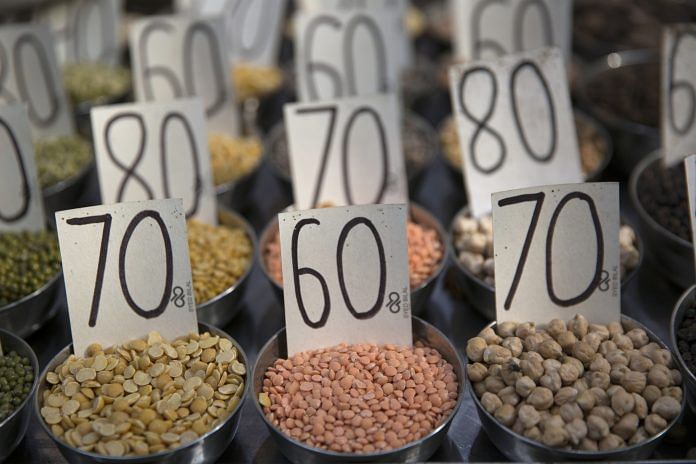New Delhi: The above-normal monsoon rainfall has led to a drop in production of soybean and pulses, despite a record increase in acreage of major Kharif crops.
The monsoon rainfall across the country has seen a surplus of 6.6 per cent in a season in which farmers sowed their Kharif crops in 6.3 per cent more area as compared to last year.
The excess rainfall has led to flooding and water-logging in farmland, and has also sparked pest attacks that have damaged crops such as soybean, onion, urad and moong in major production states of central and western India like Maharashtra, Madhya Pradesh and Karnataka.
12-15% drop in soybean crop in Madhya Pradesh
A loss of 10-15 per cent is likely to occur in soybean crops in Madhya Pradesh, which is a top producer of the commodity in the country, Ajeet Kesari, principal secretary in the state farmer welfare and agricultural development, told ThePrint.
“Major damage is seen in soybean, which is the largest grown Kharif crop in the state. Heavy rains have also hit moong and urad crops in key growing regions,” Kesari said. “The impact varies across regions, with the damage as high as 20 per cent in some areas, while in others it is limited to 2-3 per cent.
“According to a survey by the Indian Institute for Soybean Research, almost 12-15 per cent of the soybean crop in the state could be damaged,” he added. The damage to the early Kharif crop would be as high as 6,91,000 lakh hectare.”
The estimated output loss to soybean in Madhya Pradesh is due to large-scale pest infestation and waterlogging in the farmlands. Most affected districts in the state are Indore, Dewas, Ujjain, Dhar, Sehore, Harda, Shajapur, Mandsaur and Neemuch.
Bhagwan Meena, the MP-based convener of the farmer body Kisan Swaraj Sangathan, told ThePrint: “The damage is mostly caused by sudden very heavy rains and variation in temperature that has led to large scale (pest) attacks on soybean plants. The soybean crop has turned yellow in all the affected areas because of diseases and also because of the yellow mosaic virus.
“Water-logging due to heavy rains has led to decay of crops of moong and urad in roots and pod development,” Meena added. “This will further decrease the productivity per area in the state despite a record acreage in crops like soybean.”
Also read: India’s cotton exports set for revival over global demand for masks, lower domestic prices
No better in Karnataka, Maharashtra
Excess rain has impacted the harvest of onion and moong crop in the major producing regions of Karnataka and Maharashtra as well.
Heavy damage has been recorded in both states, which have increased acreage of the crop this year. In Karnataka, moong has been sowed on 3.85 lakh hectares which is about 50 per cent higher than the previous year. Similarly, in Maharashtra, the area under moong has gone up by 19 per cent to 3.84 lakh hectares.
“The rains over the past two months has severely impacted farmers. The extreme rains in August have damaged crops across 1.6 lakh hectare. Belagavi, Bagalkot and Haveri which are among the worst-hit districts, where various crops are under floodwaters,” Patangay Jayavanth Rao, director, NAFED (National Agricultural Cooperative Marketing Federation of India) in Karnataka, told ThePrint.
“Continuous rains have impacted the harvest of moong crop in major producing regions of North Karnataka and parts of Maharashtra as fresh crop is highly perishable due to higher moisture content,” Rao added. “Farmers are facing difficulty in harvesting and drying the crop so are traders in storing them.”
According to All India Crop Situation of the Ministry of Agriculture, the rainfall received in the country has been 6.6 per cent above normal.
Also read: 4 states want Centre to extend paddy procurement deadline as lockdown and rain hit season






